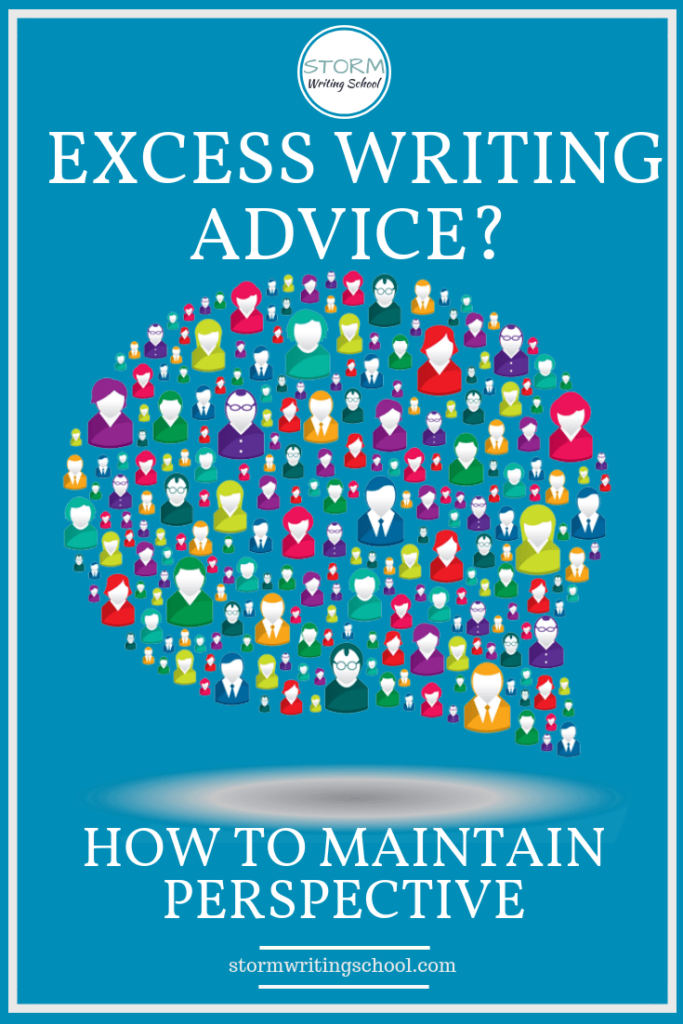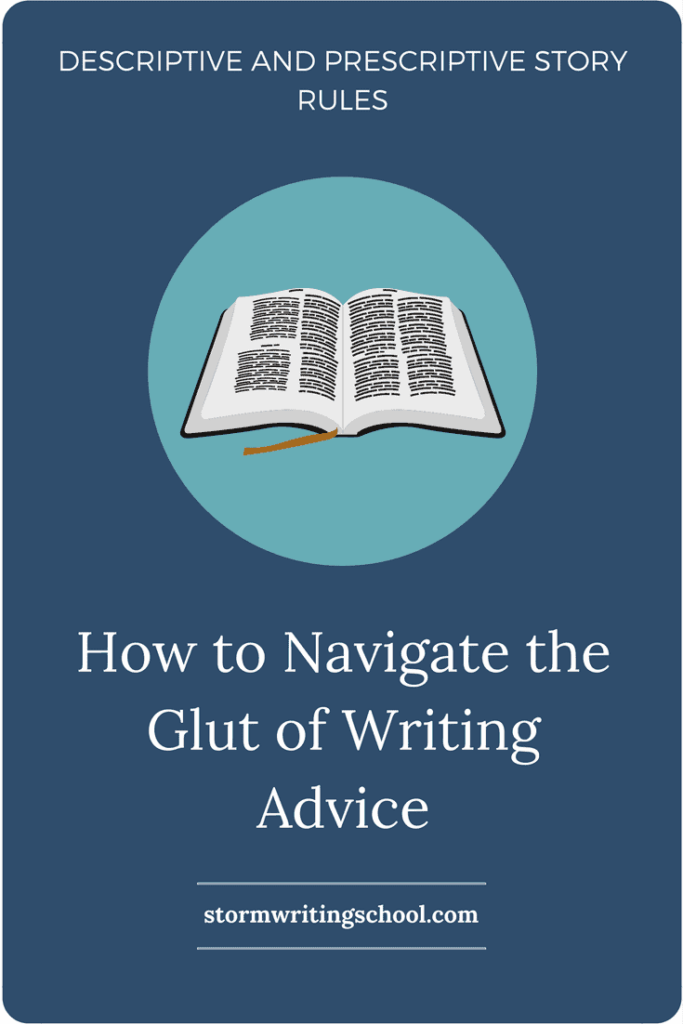So Much Writing Advice
There’s a lot of writing advice out there. It is not difficult to find. It is also not difficult to feel overwhelmed by it all and, consequently, a bit inadequate as a writer. If you’re like me, you may question yourself on occasion. Am I doing this right? Should I be waking up at 4:00am every morning to write for three hours? Should I not write in first person? Should I be outlining using the hero’s journey? My God, do I need to tweet?
I have sometimes been guilty of stalling a project because I wasn’t sure if my approach to it was the best. Maybe I’d find some craft book out there that would tell me how best to go about things.
Of course, as with anything, the key to getting better at writing is, first, to do it. Write. Make some time.
From there, though, the advice is harder to parse.

Description vs. Prescription
For years, I taught a grammar class at the high school level, and I drew largely upon my several linguistics classes from college for a foundational tenet: though we often understand grammar to mean “correct grammar,” or the way one “should” write and talk, grammar actually just means “the building blocks of language.” When a linguist studies a grammar, she might identify “rules.” But she’s identifying descriptive rules, not prescriptive ones.
This is a key differentiation.
Dorothy Sedler begins her book The Anatomy of English with this fun challenge: turn this “apparently random collection of words into an English sentence: very, cave, looking, six, out, tigers, the, mean, of, came.”
Go ahead. Try it. Then after you have, click “show” below.
[showhide type="pressrelease" more_text="Show" less_text="Hide" hidden="yes"]
It’s a safe bet that you wrote one of the following sentences:
Six very mean looking tigers came out of the cave.
Six tigers came out of the cave, looking very mean.
Six tigers, looking very mean, came out of the cave.
Sedley says, “You didn’t write six very tigers or mean very looking; you knew you had to write out of the cave, not out of cave or out cave of; and it’s highly unlikely that you wrote tigers six. These facts prove that you know English grammar, even though you may not be able to articulate what it is that you know or how you know it.”
[/showhide]
[su_highlight background=”#f1dffe”]Language is “ungrammatical” when it “deviates from the ordinary structure in such a way as to be unlikely in the speech of adult native speakers except perhaps as false starts, slips of the tongue, or intentional deviation for artistic or shock effect.”[/su_highlight]
Sedley gives another exercise to illustrate a grammatical rule. She provides a list of sentence pairs and asks us to mark the sentence in each pair that is ungrammatical—that is, those that you’re unlikely to hear a native English speaker utter:
Many apples were in the basket. OR Much apples were in the basket.
How many students came? OR How much students came?
There are many reasons for . . . OR There are much reasons for . . .
Many energy was expended. OR Much energy was expended.
How many money do you have? OR How much money do you have?
For the rule, click below:
[showhide type=”pressrelease1″ more_text=”Show” less_text=”Hide” hidden=”yes”]
We use many with a noun that can be pluralized because it names something countable (a count noun) but we use much with ones that name something perceived as an undifferentiated mass or collection rather than a countable unit (non-count noun).
[/showhide]
[su_highlight background=”#f1dffe”]As Sedley says, “You were probably unaware that you knew the rule or even that there was such a rule.”[/su_highlight]
But there it is. You know grammar. But you can’t always articulate the rules.
In the same way, you know story grammar—that is, you know when a story is gripping or well-structured or emotionally powerful. You just can’t always articulate why. You don’t necessarily know the descriptive rules behind a story’s momentum or poignance.
Sometimes, all it takes is for someone to point out story grammar to you and suddenly, you’ll feel like you’re in control of your storytelling.
Prescriptive Rules
There is, however, such a thing as a prescriptive rule. In the grammar world, such rules are known as “usage” rules. These are the shoulds.
- For instance, you shouldn’t use a double negative in English. Thus, “I don’t want no trouble” is “wrong.”
- Subjects and verbs should agree in number. Thus, “He don’t care” is “wrong.”
- You shouldn’t use a comma splice. Thus, it’s wrong to write, “Sally loves watermelon, Jim hates it.”
The above “wrong” sentences aren’t ungrammatical, but they’re not Standard Written English, which is the most accepted form of English articulation among the English-speaking establishment. You will be understood if you use double negatives. But you may not be respected.
Some writing advice is prescriptive. Don’t write a prologue. Don’t begin a story with someone waking up from a dream. Don’t use semicolons. Avoid adverbs. Show, don’t tell. Make sure your first act ends at the 20-25% mark of the story.
Are these hard-and-fast rules? No.
The “establishment” in writing is the publishing world. But it doesn’t necessarily have the same consensus as Standard Written English does. There are books that codify Standard Written English. But there are no books that codify Standard Story.
Thank God.
No Standard Story
Why are the rules not as rigid for storytelling? Because
- Publishing is driven by money. What sells = good. And so, it’s not at all uncommon to see some very imperfect writing and storytelling in bestsellers. It would be foolish to codify standard rules in a world governed by human tastes.
- Publishing not driven by money is driven by art. And art likes to stretch the rules. Robert McKee, in his book Story, points out that in addition to “Archplot,” which is mostly what I study and strive for, there are also “Miniplot” and “Antiplot,” which subvert some of the classic story structure norms, mostly for an intellectual, rather than an emotional, effect.
- Self-publishing. The publishing industry is no longer the sole gatekeeper for what enters the public discourse. Hence, a book like The Martian by Andy Weir can be rejected by literary agents, then self-published in serial form on a blog, then sold by the author on Amazon before being picked up by a traditional publisher, making the NY Times bestseller list, and then being turned into an Oscar-nominated film starring an A-list actor. In short, the establishment is occasionally wrong. Really wrong.
As a result, the shoulds of the story writing world are not as nonnegotiable. You can write a prologue. You can use semicolons. Might you have a harder time selling your book to a publisher if you defy their “usage rules”? Yes. But the usage rules are not universal. They’re trends. Currently, for instance, prologues are discouraged. But they’re not dealbreakers.
There is, of course, some advice that’s hard to pin down as descriptive or prescriptive. “Don’t open a story with long exposition” is kind of both. I mean, exposition definitely stalls momentum and does not hook people as much as conflict and action. That’s just the way the human brain works in relation to narrative. So advice against it is not necessarily just prescriptive advice.
But you do sometimes see very prescriptive formulations of that advice. And opening exposition is currently not in vogue. Certainly, there are older novels that begin with huge info dumps. And there are even marvelous stories, like Victor Hugo’s Les Miserables, that pepper their narratives with inadvisable history lessons. Such stories were acceptable to audiences who had fewer stories to choose from. But Hugo’s info-dump chapters were always a momentum-stopping technique, I’d argue.
The Takeaway
So what? How, then, should we parse the writing advice out there?
- Be suspicious of prescriptions for your writing process. People work in different ways. Anyone telling you what habits you need to cultivate should be taken with a grain of salt. Might such advice be helpful? Yes, absolutely. But don’t feel peer pressured. Experiment and find your own habits. I like Emma Darwin’s first “rule” of writing: “Never follow a rule until you understand why someone’s made it, and then treat it as advice, not law.”
- Be wary of formula. The hero’s journey was originally a descriptive tool for understanding how and why stories around the world seemed to share a lot of the same structure elements. Using it as a prescriptive tool might not work for you. And if it doesn’t, that’s okay. You don’t have to fit your story to it. Now, you might very well find that your story still follows the hero’s journey once it’s done—I’ve seen multiple writers land on a hero’s journey after ditching it as a prescriptive tool. But is it a necessary template? No! Again, this comes back to process. What works for you may not be what has worked for others. Experiment.
- But remember that writing, like all communication, is social. You are not the lone genius, writing words that nobody can understand. If nobody can understand what you’re doing, it is, by definition, bad writing. Get opinions and second opinions. Find critique partners, beta readers, workshop groups. Ultimately, you do need to listen to other people.
- And know that there are some universals. Storytelling is a uniquely human endeavor. There are some storytelling techniques—not formulas—that will work on most of the people most of the time. It can’t hurt to learn about these universals. A book like Robert McKee’s Story is a good place to start for story imperatives. It doesn’t give a whole lot of practical, actionable advice, which is what a lot of people tend to look for in craft books. But wrapping your head around story grammar can’t hurt; whereas coming to embrace bad prescriptive advice can.
The article originally appeared as “Story Grammar: Distinguish Between Descriptive and Prescriptive Story Advice.”
If you found this article interesting, you may want to take a look at some the following, too:

SaveSave
SaveSave
SaveSave
SaveSave
SaveSaveSaveSave
SaveSave
SaveSave
SaveSave
SaveSave
SaveSave
SaveSave






2 Responses
Tim, what is the rationale for avoiding semicolons?
The rationale: semicolons are pretentious and academic. Not everyone believes this. For the record: I don’t. I love semicolons.